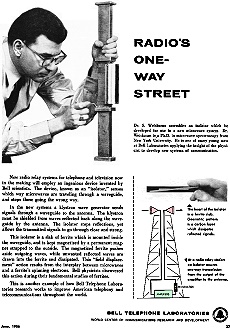Bell Telephone Laboratories - Isolators |
||||||
This full-page advertisement by Bell Telephone Laboratories in the June 1956 issue of Radio & television News seems to imply that their Dr. S. Weisbaum and/or his contemporaries was/were the original developer/s of the waveguide isolator. If so, it would be no surprise since Bell Labs was responsible for many technology innovations during its history - RF, microwaves, telephony, information theory, switching, transmission lines, test and measurement, and much more. Other information available on the Internet assigns credit to Bell Labs in the same timeframe. From the ad: "This isolator is a slab of ferrite which is mounted inside the waveguide, and is kept magnetized by a permanent magnet strapped to the outside. The magnetized ferrite pushes aside outgoing waves, while unwanted reflected waves are drawn into the ferrite and dissipated. Bell physicists discovered this action during their fundamental studies of ferrites." Bell Telephone Laboratories Isolators Dr. S. Weisbaum assembles an isolator which he developed for use in a new microwave system. Dr. Weisbaum is a Ph.D. in microwave spectroscopy from New York University. He is one of many young men at Bell Laboratories applying the insight of the physicist to develop new systems of communication . New radio relay systems for telephony and television now in the making will employ an ingenious device invented by Bell scientists. The device, known as an "isolator," senses which way microwaves are traveling through a waveguide, and stops those going the wrong way. In the new systems a klystron wave generator sends signals through a waveguide to the antenna. The klystron must be shielded from waves reflected back along the waveguide by the antenna. The isolator stops reflections, yet allows the transmitted signals to go through clear and strong. This isolator is a slab of ferrite which is mounted inside the waveguide, and is kept magnetized by a permanent magnet strapped to the outside. The magnetized ferrite pushes aside outgoing waves, while unwanted reflected waves are drawn into the ferrite and dissipated. This "field displacement" action results from the interplay between microwaves and a ferrite's spinning electrons. Bell physicists discovered this action during their fundamental studies of ferrites. This is another example of how Bell Telephone Laboratories research works to improve American telephony and telecommunications throughout the world. The heart of the isolator is a ferrite slab. Geometric pattern is a carbon layer which dissipates reflected signals. At a radio relay station an isolator assures one-way transmission from the output of the amplifier to the antenna. World Center of Communications Research and Development
Posted June 3, 2019
|
||||||


